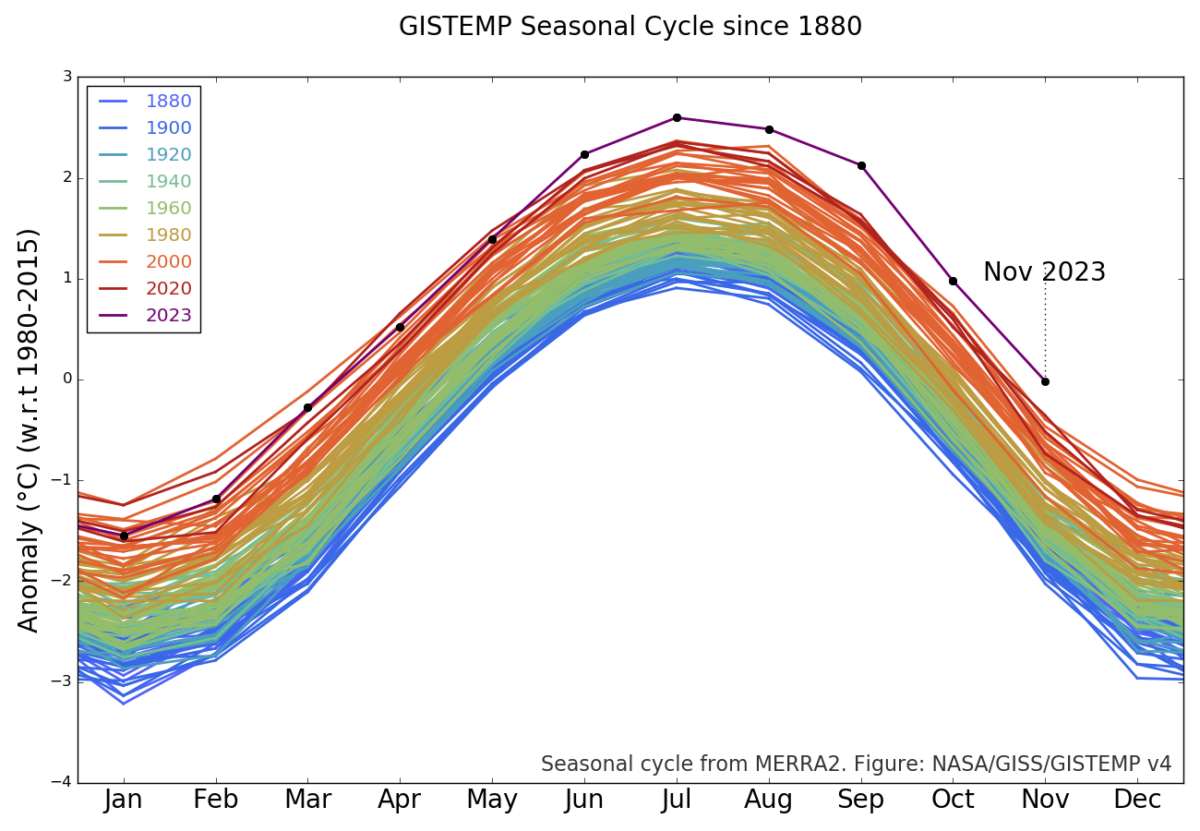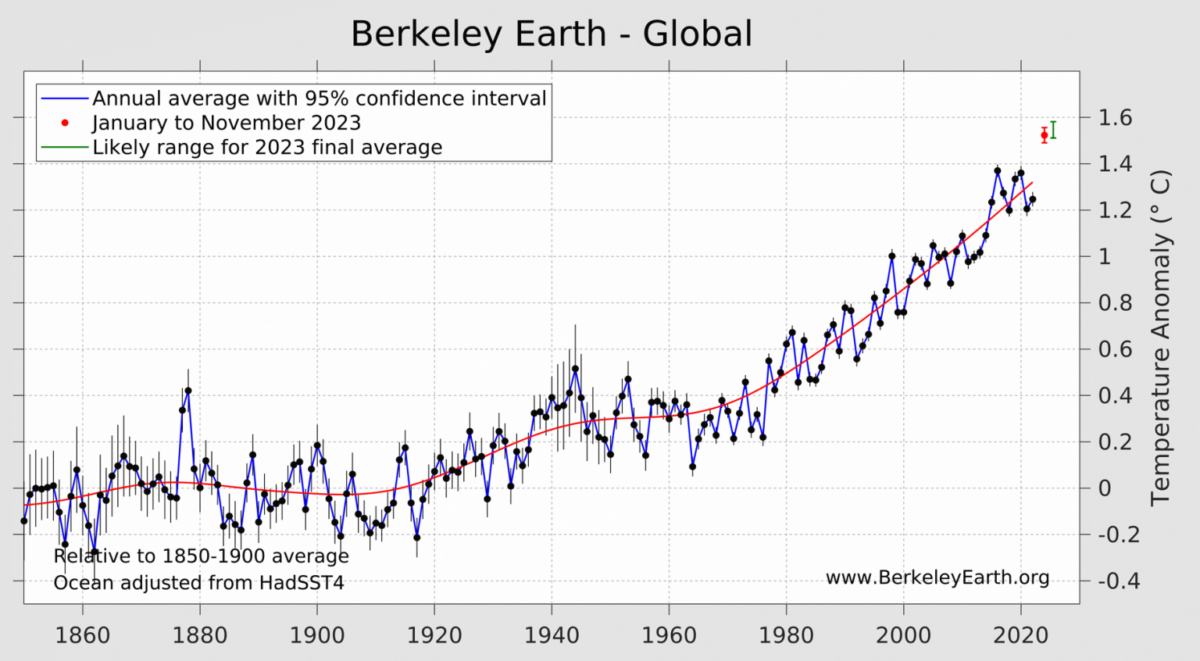~~ recommended by collectivist action ~~
Our climate has crossed the “dangerous” 1.5 degrees Celsius warming threshold generations ahead of projections.

Our climate has crossed the “dangerous” 1.5 degrees Celsius (2.7 degrees Fahrenheit) above normal warming threshold 50 years or more ahead of long-held projections, according to data analysis by a major climate organization. Of the four major Earth temperature evaluations released for 2023 so far, Berkeley Earth is at 1.54°C, the European Meteorological Service is at 1.48°C, the World Meteorological Service is at 1.45°C and NASA is at 1.44°C. Almost all climate change impacts are happening decades, generations and even a century ahead of projections.
As recently as 2021, the Intergovernmental Panel on Climate Change (IPCC) said we would not cross the 1.5°C threshold until after 2032. The IPCC’s 1.5°C Report in 2018 said that a constant rate of warming from the mid 2020s would see us exceed 1.5°C warming in 2040.
Berkeley Earth says, in 2023, every month from June to December was warmer than the previous record warm month; something never before seen in the temperature record. Almost half of the days in 2023 were warmer than 1.5°C, more than doubling the previous record. Two days in November were above 2°C, a first ever occurrence.
What’s so important about a little warming? If the average warming on Earth today of 1.54°C is the land-ocean average, then warming over land is twice that over the cool oceans — on average, 3.08°C (5.4°F). Then consider that heat extremes are many times the average, and what seems like a paltry 1.5°C warming becomes a very large number with obviously dangerous implications.
This extreme jump in temperature can no longer be altered by simply eliminating future emissions. It has been caused by current warming from prior emissions, including feedback emissions, from collapsing Earth systems and from cascading effects that amplify warming nonlinearly. In just two years in 2023 and 2024, global temperatures could rise as much as half of all excess planetary warming humanity has experienced in the last 200 years.
The 1.5°C warming threshold has now been surpassed in a big way. James Hansen, the retired but still publishing 32-year director of the National Aeronautics and Space Administration (NASA) Goddard Institute for Space Studies (the de facto United States climate modeling agency), says it’s quite likely that Earth’s temperature will not fall below 1.5°C again (unless we restore our climate, of course). We should anticipate climate disruptions far more extreme than what we have endured so far, as end-of-century impacts are now advancing to our immediate future.
The temperature spike in 2023 was truly remarkable: December’s warming was 0.30°C higher than any previous December in the 173-year thermometer record and three times more than the previous record in 2019. November’s warming was 0.38°C higher — five times more than the previous record. October was 0.26°C — three times higher than the previous record. September was six times higher at 0.45°C; August was four times higher at 0.26°C; July was twice the previous record at 0.21°C; as also June at 0.14°C. Prior to June, the warming rate was not substantially different from the trend of the previous 172 years.

Climate scientists warned us that if we did not reduce our greenhouse gas emissions, planetary warming would advance into a new and more acute mode where solutions become different, impacts increase nonlinearly and effects become irreversible. They urged us to understand that actions to limit emissions would likely eliminate the risk of entering this more acute warming mode, and that delay and lesser-than-suggested actions could cause warming acceleration to arrive sooner, with more extreme impacts and existential risks.
Over the last 30 years, the accumulated concentration of excess carbon dioxide in the atmosphere has doubled. And in the last 10 years, the planet’s warming rate has more than doubled, amplified by the greenhouse gases already accumulated in our atmosphere. If we had stopped emissions a decade or more ago, we would still be seeing the current vault in global temperature from warming already locked in because cessation of emissions does not halt warming in time frames that matter.
The cause of this unexpected temperature spike can be related to five different things, some of which are natural but fleeting. First, there is the rebound from the just passed, triple-dip, unusually long La Niña. This three-year cooling period in the Pacific Ocean’s surface temperature in the equatorial region has masked some global warming that would have otherwise occurred. Second, there’s the flip to El Niño — the warming of the equatorial Pacific. The year 2023 was initially projected to be no big deal on the warming scale because La Niña was projected to end in late spring or early summer. It takes about half a year for Earth’s temperature to warm back up after a La Niña. El Niño, too, lags in causing Earth’s temperature to warm. Its warming impact, while present, was likely low for most of 2023. These two things alone, however, do not explain the sheer enormity of the temperature jump.
The January 2022 Hunga Tonga-Hunga Ha’apai volcano eruption could counterintuitively be playing a warming role, but we still don’t know for sure as there are conflicting findings. Volcanic eruptions have a long track record of cooling the climate. Tonga was an undersea eruption that injected so much water into the stratosphere that it overwhelmed the normal cooling caused by sulfur oxide aerosols from a volcanic plume. Sulfur oxides (or sulfate aerosols) create global cooling by reflecting light from the sun back into space before it can strike an object and be changed into heat energy that can be trapped by the greenhouse effect. Sulfur oxides also aid in the formation of brighter and longer-lived clouds that similarly reflect the sun’s light.
Then there is the International Maritime Organization’s (IMO) new air pollution fuel regulations limiting sulfur content in shipping fuels that have likely played a major role in the warming jump (though Berkeley Earth says it has likely only added a few hundredths of a degree Celsius so far). Sulfur oxide emissions from burning fossil fuels are one of the leading causes of 6.7 million air pollution deaths per year globally. Strict sulfur emissions limits have been in force for generations in the U.S. and Europe, with the exception of ship fuels and direct injection gasoline engines. In 2010 and 2015, the new IMO limits went into effect in critical near-shore areas. In 2020, full-force reductions of about 85 percent went into effect globally. Much like volcanic emissions, sulfur oxide air pollution from fossil fuels are global cooling emissions. Sulfur and other global cooling emissions have masked a third of the warming that should have taken place to date.
With ship fuel sulfur, there is additional cooling where a ship’s exhaust creates cloud trails similar to jet condensation trails, except they are immediately above the water. Because the sulfur oxide emissions from ship fuel enhances cloud brightness, ship trails now reflect less sunlight back into space too. This is especially important because our oceans are extremely efficient at changing sunlight into heat energy. Ninety percent of sunlight striking a significant water body is absorbed and changed to heat where the whitest clouds reflect 90 percent of sunlight back into space. The worst place to limit sulfur emissions then is over the oceans.

New regulations in automobile transportation are also important. The most common engine fueling technology is now direct injection, because of greater efficiency. However, the process creates twice the sulfur particulate emissions as traditional fueling processes. Because these sulfur oxide particulates are so small, they weigh almost nothing and are not regulated by previous particulate emissions standards based on weight. New regulations in 2014, 2017 and 2020 in Europe and China reduce these emissions, and as more new cars are produced, more warming is unmasked. The U.S. is notably behind in advancing these new regulations.
The last thing increasing warming is climate tipping. There is much controversy over the idea of tipping, centering around when it begins and what it means, that arises from the academic definition of tipping, which is described as processes of Earth systems’ collapses that are often abrupt, irreversible and generally result in feedback emissions of greenhouse gases in quantities that dwarf human-generated emissions. The definition, however, fails to consider the reversible phase, after tipping is activated and before it becomes irreversible.
Tipping is generally a two-phase process: activation and irreversibility. Once activated, the system’s environmental services are at first degraded, then eliminated and then, often reversed due to things like a stable sea level, hospitable agricultural areas, and runoff from mountain snows that sustain us. The most important is greenhouse gas sequestration, where healthy Earth systems absorb greenhouse gases (our forest systems). To reverse the collapses and eliminate the tipping response of feedback emissions, the cause (warming), must be removed before the irreversible “point of no return.” If the system collapse is not reversed, the momentum of the collapse continues. These tipping response emissions or feedback emissions are beginning to happen now, and are likely being reflected in 2023’s sudden acceleration in temperature rise.
A textbook example of emerging feedback emissions is from our planet’s forests. Earth’s climate has now warmed beyond the evolutionary boundaries of its ecosystems. This means their collapses have (generally) been activated such that they may re-evolve with species tolerant of their new conditions. The Amazon is now emitting one gigaton (one billion tons) of greenhouse gases as CO2eq every year and no longer sequestering or absorbing them (CO2eq is all climate pollution “equivalents” evaluated as CO2, i.e. carbon dioxide). Of these emissions, only 25 percent come from human-caused deforestation. This one gigaton is also just the emissions from the Amazon rainforest.
Permafrost collapse emissions represent 2.3gt CO2eq annually, including drowned forests. Canadian forests are emitting 350 megatons CO2eq annually, almost all from mountain pine beetle kill and not including permafrost forest drowning. (Escalating wildfires in Canada are not yet substantially included in this evaluation.) A 2015 study by N.G. McDowell et al., tells us that forest mortality across the western U.S. and Canada has doubled and quadrupled between about 1980 and 2010. A separate 2023 study by Kyle C. Rosenblad et al., found that forest mortality increased eight times in western U.S. from 2010 to 2018. Another 2023 study by Qiuyu Liu et al., found Canadian forest mortality more than doubled from 1970 to 2020. David Bauman et al., found in 2022 that Australian tropical forest mortality doubled between 1984 and 2019 and the forest has flipped from sequestration to emission. Bauman told Truthout he believes it likely that tropical forests globally are behaving similarly to Australian forests due to similar water stress. The crux is that when forest mortality doubles, both forest age and corresponding carbon storage are halved. By extension, on average, forests globally are now emitting, not sequestering; or soon will be.
So what does 2023’s sudden temperature jump actually mean?
For starters, plan on extremes that far outpace what we’ve already endured. Warming from El Niño and the Tonga eruption will dissipate, but the increased warming rate from feedback loops will increase further. Warming from reduction of ship fuel sulfur and direct-injection land-based transportation engines are permanent and will likely continue to increase for a while. The sudden rise in temperature obviously increases the risk of tipping and likely surpasses irreversible tipping points.

Now that this abrupt warming threshold has been crossed, emissions reductions or even complete emissions elimination can no longer change our future in timeframes that matter. The cure now is to restore our climate back to within the evolutionary boundaries of our Earth systems — before the point of no return.
The point of no return is something very difficult to disentangle from low-resolution prehistoric evidence. The risks from out-of-control feedback loops require that we cool immediately because the risk of existential outcomes is so high. We don’t have a choice.
However, carbon dioxide removal is slow and decarbonization is very slow. Later is too late. Tipping collapses will likely become irreversible with no further warming above 1.5°C. The natural greenhouse gas emission feedbacks caused by this new rapidly accelerating temperature phase of climate change are very dangerous. The ongoing catastrophe obligates us to engage in difficult discussions and principled debates about the need for evidence-based geoengineering and temporarily rescinding sulfur population regulations until we get our climate under control, as such actions may permit enough time for carbon dioxide removal and decarbonization to become effective and save future generations.
No comments:
Post a Comment